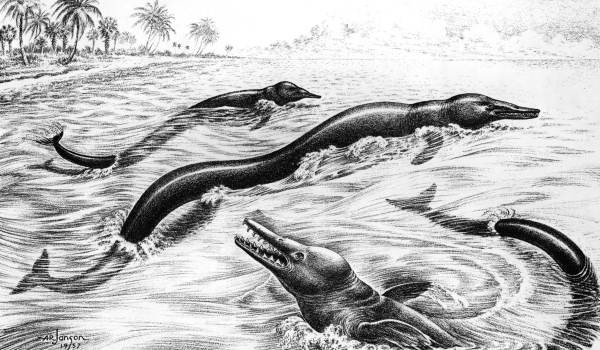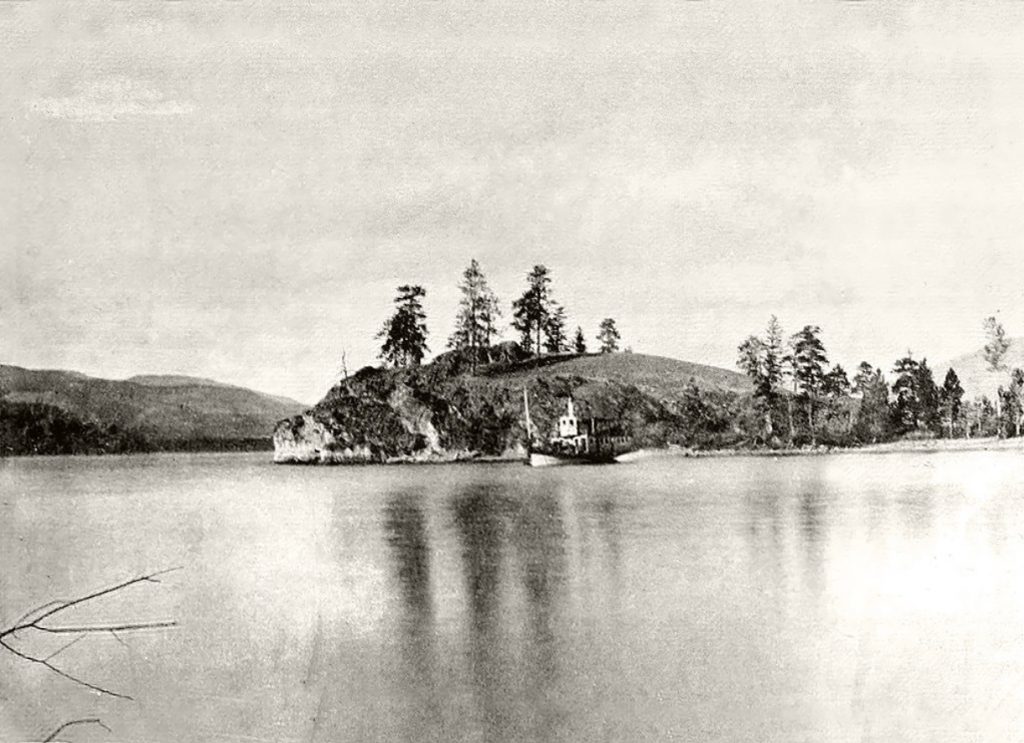
Date of Discovery
In 1872, the first detailed account of Ogopogo from a white settler came from Susan Allison. As the first non-native person to live in the region closest to Lake Okanagan, she confirmed her sighting with the native people of the area, who told her about N’ha-a-itk–the original name of Ogopogo. It’s clear from her experience that the indigenous people of the area were clearly aware of this lake monster well before it became a part of the written lore of the region.
Name
The Ogopogo, or Oggy is often referenced to by its original name which is N’ha-a-itk, and Naitaka which it received from the indigenous population. N’ha-a-itk in Séliš (the anglicized version, Salish) which translates to the “spirit of the lake; snake of the water; or water demon.”
Physical Description

Ogopogo is most commonly described as being a serpent that is between forty and fifty feet long, and Karl Shuker, a British cryptozoologist that has categorized it as a many-humped variety of lake monster. It has often been suggested that the Ogopogo is actually the same kind of primitive serpentine whale as a Basilosaurus. Physical evidence for this lake monster has been limited to unclear photographs, which cause these sightings to be doubted, giving way to explanations that they’re really misidentified otters swimming in formation, or floating logs.
Origin
Originating from the indigenous people in the Okanagan Valley in British Columbia, Canada–the Ogopogo lives in Okanagan Lake. It is sighted most frequently around Rattlesnake Island, where it is said he lives in a naturally occurring cave underneath the island. Lake Okanagan is the largest of five inter-connected freshwater fjord lakes in the Okanagan Valley, and it is named after the indigenous tribe that first inhabited the area. The lake was created by melting glaciers when they flooded the valley over ten thousand years ago, and it stretches approximately seventy-nine miles. With a maximum depth of 762 feet and an average depth of 249 feet, the Okanagan Lake has frozen over during only eight winters in the last 110 years.

Mythology and Lore
Ogopogo is more closely intertwined with the area’s native folklore than any other lake monster known to exist. The Secwepemc and Syilx tribes called the lake monster Naitaka and N’ha-a-itk, and they regarded the creature as an evil supernatural entity with enormous power and malicious intentions. Within the folklore of these tribes, it was said that Naitaka demanded a live sacrifice in order to allow safe passage across the lake, so for hundreds of years, the people of these tribes would sacrifice small animals before entering the water.
In some of the oral traditions that are passed down, there is a visiting chief by the name of Timbasket, who rejected the idea of sacrificing an animal for safe passage–he rejected the very idea that Naitaka even existed. In response to this insult, Naitaka, “whipped up the surface of the lake with his long tail,” which caused the canoe to capsize and its occupants to be sucked down to the bottom of the lake. There are many stories in which Naitaka has been described to have used its tail to create a fierce storm in the water and drown its victims.
Within local folklore, Sir John Lambton was claimed to have killed a “wyrm,” from the lake, which resulted in all of his descendants to be cursed by a witch that would not allow any Lambton to die in bed. In 1855, John MacDougal, a settler claimed that his horses were pulled down into the water and his canoe would have followed if he hadn’t cut the line just in time.
Modern Day Sightings
In 1968, Art Folden noticed something moving in the lake while driving on Highway 97–he pulled off of the road and filmed footage that he claimed was the lake monster in a large wake that was moving across the water. He estimated that Ogopogo was around 300 yards off the shore of the lake and computer analysis of the footage concluded that it was a solid, three-dimensional object. Folden said he noticed something large and lifelike in the distance of the calm water which caused him to pull his home movie camera to capture the object.
Just off the beach at Kelowna, in 1980 a tourist by the name of Larry Thal from Vancouver shot some 8mm film that lasted for approximately ten seconds, while he and around 50 other tourists watched what they claimed was a forty-five minute long Ogopogo sighting. Many skeptics believe that it was a misidentified sighting of swimming otters. In 1989 John Kirk believed he saw an animal that measured between 35 and 40 feet in length, black in color, had a lashing tail, and five sleek humps. In Kirk’s opinion, the creature looked to be moving at approximately twenty-five miles per hour.
July 24, 1992 a video appeared of something that was swimming just beneath the surface of the water–the person who filmed it, DeMara, also made two subsequent videotapes that skeptics have debunked to having just been formations of otters. Much of what followed for documented sightings in 2005 were supposedly debunked was also explained away as fallen trees or yet even more often otters. John Kirk, along with Benjamin Radford, and Joe Nickell conducted an investigation in 2005 for National Geographic Channel’s Is It Real? In this investigation, they used boats to calculate the actual distances that this creature was being sighted from, but found that it was much closer than originally believed. This result gave them the conclusion that
Since technology has improved, more videos have surfaced from cell phone video captures, but this also leaves room for more mistaken sightings being more widespread, due to the availability of the technology.
Speculations About the Sightings
Author and renowned skeptic, Benjamin Radford, believes that most sightings can be explained away as misidentifications of waterfowl, otters, or beavers. He stated that the indigenous people of the land were never talking about a real monster when referencing Ogopogo, but more of a water spirit that were only myths and legends to teach people to be wary of the open water.
Modern Pop-Culture References
In Arlene Gaal’s book, Ogopogo: The True Story of the Okanagan Lake Million Dollar Monster, she tells of a Vancouver reporter by the name of Ronald Kenvyn who composed a song that included the following stanza.
His mother was an earwig,
Ronald Kenvyn
His father was a whale;
A little bit of head
And hardly any tail—
And Ogopogo was his name.
Books & Literature
Is there anything we missed about the Ogopogo? Let us know in the comments section below!

Georgia-based author and artist, Mary has been a horror aficionado since the mid-2000s. Originally a hobby artist and writer, she found her niche in the horror industry in late 2019 and hasn’t looked back since. Mary’s evolution into a horror expert allowed her to express herself truly for the first time in her life. Now, she prides herself on indulging in the stuff of nightmares.
Mary also moonlights as a content creator across multiple social media platforms—breaking down horror tropes on YouTube, as well as playing horror games and broadcasting live digital art sessions on Twitch.
